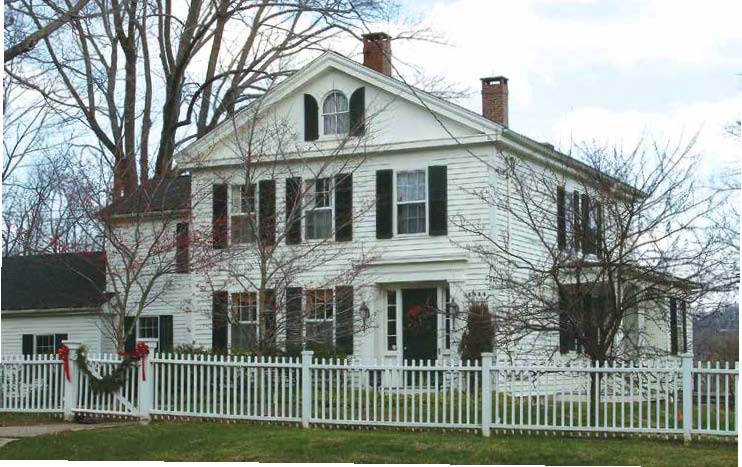Achieving success as a woman-owned painting business
 Marge Parkhurst has been painting since the age of 13, when she would accompany her father, a general contractor, on various jobs after school and during the summer months. She continued working for her father throughout high school.
Marge Parkhurst has been painting since the age of 13, when she would accompany her father, a general contractor, on various jobs after school and during the summer months. She continued working for her father throughout high school.
Fast forward 34 years, and Parkhurst has created and maintained a lucrative painting business that focuses on both commercial and high-end residential work in northwestern Connecticut. Today, Painting by Marge, Inc. is a small, woman-owned, fully insured and licensed business with a crew of six employed painters. Not traditionally an industry for women-owned businesses, she faced some challenges along the way, but her ability to identify issues and the resourcefulness she applied in finding solutions earned her not only life-long, satisfied clients but a loyal crew.
Q: WHEN DID YOU START YOUR PAINTING BUSINESS?
I was in high school when I had a dream of owning my own painting business. Not only did I love painting, but I enjoyed working for myself. I earned enough money to pay for my college tuition and obtained a degree in teaching, which is the career path I thought I wanted to take at the time. For a few months after graduation, I was a substitute teacher, then realized my true passion was painting.
In 1984, I established Painting by Marge and became an incorporated business in 1992. Our logo is a pineapple, which is a symbol for hospitality and has been well-received by our clients and the community.
Q: WHAT CHALLENGES HAVE YOU FACED?
Once I decided to pursue painting as a profession, I began by completing projects for family and close friends. I never had a problem finding work and became so busy that I had to start hiring staff.
Early in my career, I had an all-female crew who were eager to learn the skills required to prep and paint. It did become challenging at times, however, to maintain project deadlines because most of my crew were also moms who needed to be home when their child was sick or had a day off from school. As a solution, I hired a babysitter who was available to watch all of our children at my house so that we could stay on schedule.
As a mom of three, I also had to make some adjustments, such as always scheduling work within 10 miles of my home so I’d be nearby if my children needed me, and I did all of my estimating and paperwork in the afternoons from my home office, so I could be there when they got off the school bus.
Over the years, the business continued to grow so I eventually added more crew, consisting of both women and men. I was surprised when I noticed my clients approached my male employees instead of me if they had a question or concern. At the time, I think the nature of the industry was very male-dominated so it made sense, but I quickly discussed the issue with my team and instructed them to politely redirect clients to me.
Another thing I learned is that, in order to be successful as a woman in this business, you must dress the part. I’ve found that I need to show potential clients that I can do the work. So instead of wearing professional business attire to bid a job, I wear painters pants and a company t-shirt.
Q: HOW HAS THE INDUSTRY EVOLVED IN REGARD TO EMBRACING WOMEN?
I think home improvement shows have really shed light on the number of women who are actively involved in this industry. I believe women who own a painting business have the unique opportunity to really connect with their clients on a personal level because it’s often the women clients who are the ones at home greeting the painter and communicating about the job. I’ve found that [my female] clients feel comfortable working with me and trust me and my team of painters. But I still show up to every job and always check in with my crew so I can communicate with my clients, provide progress updates, and discuss any issues that may arise.
While there are a lot more women in the industry today than I think are known, I often wonder if women don’t choose this profession because they don’t think it’s a job they can easily do. I couldn’t disagree more. It’s a skill that can be learned with good mentorship and training.
Q: WHAT DO YOUR CLIENTS LIKE ABOUT YOUR COMPANY?
Up in this part of Connecticut, there are large estates that are 5,000 square feet and above and are owned by young professionals who work in New York or New Jersey, just a few hours away. These old, historic homes are mainly only occupied on the weekends, so these homeowners are looking for contractors who are highly dependable and extremely trustworthy. They rely on me to send pictures of their projects so they can stay well informed. Not only do I develop good working relationships with my clients, but they often become personal friends—and clients for life.
I also offer a four-year warranty on all residential jobs and I maintain all of my clients’ houses. If there is any damage to the home as a result of bad weather or if I notice something needs to be fixed, I’ll reach out to them. This usually generates more work because I’m often asked to paint on the interior or exterior of the home while I’m there.
Q: HOW DO YOU PREPARE BIDS?
When I was raising my children, I spent a lot of time late at night working on bids. I needed something to generate estimates faster, so I came up with an idea to launch a computer program that would allow me to enter all the specific job information and produce an estimate. I contacted a software developer who used that vision to develop the Painter’s Estimating Program (PEP). I trademarked the business and marketed it to other painters.
A few years later, I sold the business to the programmer I hired who helped me work on the program. He has made some great updates and improvements to the software. I still use PEP to this day to accurately prepare bids for my clients. My crew also has access to the software and can look up important details including the products and materials, number of coats required, and hours budgeted and currently spent on the job .
Q: WHAT DO YOU HAVE PLANNED FOR THE FUTURE OF YOUR BUSINESS?
I’ve always said that I’ll stop working when the job is no longer fun. I’m still enjoying it, but I’ll be 65 in August and have started to think about retirement.
My plan is to sell the business to one of my employees (I’m grooming two of them) to make sure my clients continue to get a really good paint job from crews who really pay attention to detail and have integrity and sincerity for the job.
Toward that end, I’ve stopped spending so much hands-on time at every job. I still check in on each one but I now mainly focus on providing bids to new clients. I’m fortunate to have a great team and am thankful for a dependable crew who have significantly contributed to our success.
_________________________________________________________________________________________
 Marge Parkhurst is the owner of Painting by Marge, Inc., a premier residential and commercial painting business that is recognized as a ‘Woman Owned Small/Minority Business Enterprise’ by the State of Connecticut. Parkhurst is also an active member of the PDCA. PaintingByMarge.com
Marge Parkhurst is the owner of Painting by Marge, Inc., a premier residential and commercial painting business that is recognized as a ‘Woman Owned Small/Minority Business Enterprise’ by the State of Connecticut. Parkhurst is also an active member of the PDCA. PaintingByMarge.com




